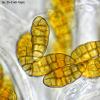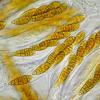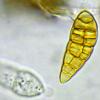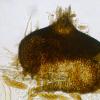
10-01-2026 20:00
Tom SchrierHi all,We found picnidia on Protoparmeliopsis mur

13-01-2026 07:28
 Danny Newman
Danny Newman
Chlorociboria glauca on indet. decorticate logThe

08-12-2025 17:37
 Lothar Krieglsteiner
Lothar Krieglsteiner
20.6.25, on branch of Abies infected and thickened

15-01-2026 15:55
 Lothar Krieglsteiner
Lothar Krieglsteiner
this one is especially interesting for me because

13-01-2026 08:43
 Danny Newman
Danny Newman
Tricladium varicosporioides on indet. decorticate

07-01-2026 22:22
 Danny Newman
Danny Newman
Tatraea sp. on indet. hardwood The Swag, Great Sm

13-01-2026 09:10
 Danny Newman
Danny Newman
Dasyscyphella chrysotexta on indet. decorticate ha
Pleospora on Clematis
Björn Wergen,
24-11-2013 18:45
 Hi friends,
Hi friends,and again, there is an interesting pleosporaleous species growin on dead Clematis stems with distinct setae on the black, hemisphaerical pseudothecia and clavate, 7-8 septated ascospores, which have indistinct, hyaline appendages on both endings (upper ending with hemisphaerical, lower one with conical appendage).
Spores are 25-31x8-10µm, asci 100-130x15-20µm, short stalked and biseriate. I have also found conidial state of very small, beaked conidiomata with Stemphylium-like conidiospores of 14-19x7-9µm.
After comparing several species with Wehmeyer, I have the idea of Pleospora dura, which has tomentose hairs instead of the stiff setae I have recorded. Probably you can tell me something about the relation in Pleospora with their conidial states. In Wehmeyer 1961, P. herbarum is described as attended by Stemphylium state.
I think its time to read Wehmeyer's works...Pleospora is still undeterminable for me :(
[NFF = anamorph, HFF = teleomorph]
Thanks to everyone who can tell me something about it.
regards,
björn
Björn Wergen,
24-11-2013 19:01

Re : Pleospora on Clematis
P. ambigua has many similarities, even if it is figured very different. Wehmeyer gives matching spore and ascus sizes and, more important, distinct stiff hairs and many substrates for this species.
He only describes the spores as "dark yellow brown to red brown"...
He only describes the spores as "dark yellow brown to red brown"...
Alain GARDIENNET,
24-11-2013 20:09
Re : Pleospora on Clematis
Hi Björn,
Perhaps have you to look towards Cilioplea species.
Alain
Perhaps have you to look towards Cilioplea species.
Alain
Björn Wergen,
24-11-2013 20:30

Re : Pleospora on Clematis
Yes you are so right, its Cilioplea coronata...oh man diese blöden Ascomyceten immer ^^
:D Thanks Alain!
regards,
björn
:D Thanks Alain!
regards,
björn
Yannick Mourgues,
24-11-2013 23:55

Re : Pleospora on Clematis
Yes, Alain is right again !
Cilioplea Munk, Dansk Bot. Ark.15(2) : 113, 1953 is a genus that shows ascocarps with short apical setae.
I remember that C. kansensis have hyaline /yellowish setae and C. coronata brown setae. Here it's clearly C. coronata !
Beautiful discovery!
Cilioplea Munk, Dansk Bot. Ark.15(2) : 113, 1953 is a genus that shows ascocarps with short apical setae.
I remember that C. kansensis have hyaline /yellowish setae and C. coronata brown setae. Here it's clearly C. coronata !
Beautiful discovery!







